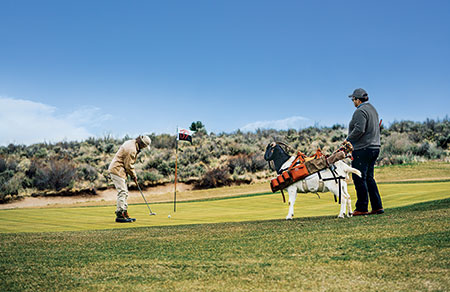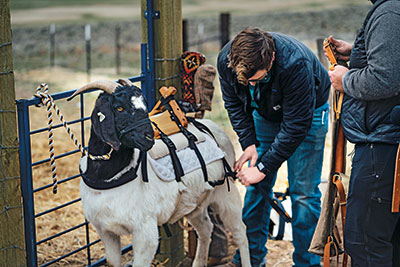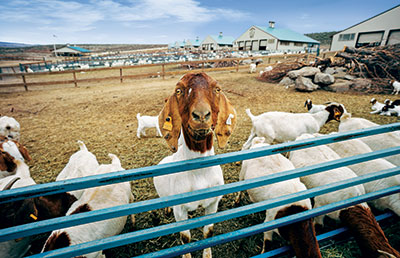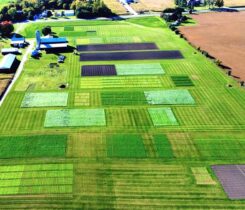Four-legged loopers

Photo: Silvies Valley Ranch/KemperLesnik
Silvies Valley Ranch is home to four golf courses. It has an 18-hole reversible course, a 9-hole course for warmup and family rounds and a 7-hole challenge course called McVeigh’s Gauntlet. Reversible courses are unique, but overall, there’s nothing strange there.
Silvies, which is located in eastern Oregon, also is home to a cattle and goat ranch. Both herds graze on the ranch and are used for meat production.
Though goat meat isn’t terribly common fare in the United States, there’s nothing too odd about that either.
But a much different fate befalls a few lucky goats, and it certainly might seem a little strange. The fortunate goats who make it out of the kitchens head up the hill to a little shack, don specially made backpacks and are employed on the golf course as caddies.
If you’ve got ’em, use ’em
The concept of goat caddies originated on McVeigh’s Gauntlet because of the challenge course’s unique terrain.
“The Gauntlet is so steep up and down and we don’t have traditional two-legged caddies, so we figured out how someone could haul their clubs around the golf course,” says Colby Marshall, general manager at Silvies. The course also doesn’t have carts, so for someone who didn’t want to or was not able to carry their clubs, there weren’t a lot of options.

In addition to the goat caddies, Silvies Valley Ranch also is home to an 18-hole reversible course. (Photo: Silvies Valley Ranch/KemperLesnik)
The solution was the goats, which are plentiful on the ranch. Some even had experience working as pack animals for the Peruvian herders who are employed at Silvies.
So, it seemed like a logical jump from having the creatures haul water and lunches and snacks for dogs to carting around a couple sets of golf clubs and a six-pack of beer.
“We got to talking about this and thought, ‘Could we actually do this?’” Marshall says. “We thought about it and thought maybe we could incorporate the goats. Could we create something that would be a unique opportunity, but also fit so well with the ranch?”
Turns out, they could. The course has been working with goat caddies for about a year and a half, and the program made its debut when the Gauntlet opened about a year ago.
Silvies currently has four goats that work as caddies, and the program is now also available on Chief Egan — the 9-hole course — because many people want to play with a goat caddie but may not want to play the type of challenging golf associated with McVeigh’s Gauntlet.
Goats aren’t great at picking out clubs, and it’s pretty likely they’ll misjudge the distance to the pin every time. So why use goats as caddies, other than that they are readily available and are familiar with being used as pack animals?
According to Marshall, the goats are extremely social and like to be around humans. The goat caddies that do best in the program are those that have been part of the bottle-baby program. Those goats are fed by humans from infancy and want to be around them because humans always have been the ones caring for them.
Goats also are quite intelligent, Marshall adds, and quickly learn the ropes of the program, especially if they’re promised peanuts — their favorite treat — for good behavior.

As the smile indicates, the goats enjoy being around humans and see themselves as part of their herd. (Photo: Silvies Valley Ranch/KemperLesnik)
“They are smart enough that you could pick them out and do a training program with them. That is totally reasonable because of the nature of the goat and because of how intelligent they are,” Marshall says. “They have this endearing nature toward people, so they’re happy to be around you, happy to work with you and they look at themselves as part of your herd.”
Working for peanuts
To carry clubs, the goats are outfitted with a special backpack designed by Seamus Golf. The packs hold two sets of golf clubs and a six-pack of beer. They also have a special compartment for the peanuts the goats crave.
As part of their training, the goats chosen for the program are outfitted with the backpacks, which are then loaded up with clubs so the goats can get used to the weight. The goats are then walked around the course either singly or in pairs.
They also spend some time stationed at various places around the course so they can get comfortable with the experience of walking around and being on a golf course. The goats are rewarded with peanuts for good behavior during training.
This process is done for weeks before a goat is allowed to officially start caddying.
If the goats are starting their training young, they also learn the process of walking and the pressure and release of the lead rope. Additionally, they spend more time getting used to the weight of the backpack, both empty and filled with clubs.
The goats have a caddie shack where their backpacks and peanuts are stored and where they wait between rounds. So they don’t forget their humble roots, they stay in the livery stables with the other livestock in the evening.

The goat caddies make hauling clubs over the rolling hills of eastern Oregon easier, without the need for golf carts. (Photo: Silvies Valley Ranch/KemperLesnik)
The goats used as caddies weigh roughly 250 pounds when they are full grown. Even with a fully loaded backpack, the goats carry only about 15 percent of their body weight, Marshall notes. “These are large goats,” he adds. “These are not the goat yoga goats — you would not want to do goat yoga with these goats. You’d have to go down to the spa and get readjusted afterward.”
The program is self-selecting, so if someone doesn’t want to use a goat they are welcome to carry their own clubs. A goat caddie runs $38 per player. They are double bagged, so it’s $77 for one goat caddie to carry for two people playing a round.
Goats on the greens
“Generally, if you want to insult a golf course superintendent, you tell him his golf course is a goat ranch, but for us out here, it’s really part of the story of the sustainability of the course,” Marshall says.
So, what exactly do goats on the course mean for the person who has to take care of the turf they’re hoofing around on?
Sean Hoolehan, CGCS, is superintendent at Silvies. He oversees all four courses at the ranch and has been there since it opened about a year and a half ago. From the beginning, he says he never gave the goats a second thought. “I had my hands full getting a golf course ready to open,” he says.
His lack of concern about the goats isn’t necessarily a bad thing. It might even suggest that the goats are doing their job well and tend to not stray too far off course and damage the turf.

The goats are well fed and watered before they go to work, so there hasn’t been much trouble from them trying to grab a snack on the job. (Photo: Silvies Valley Ranch/KemperLesnik)
It helps that the goats aren’t allowed everywhere on the course, according to Hoolehan. They mostly stick with the players.
Each goat has a ranger — a member of the outdoor experience staff at Silvies — who goes with the caddies and walks them on a lead, so the goat isn’t able to go too far out of range of the golfer or golfers it’s carrying for.
“The goal is to have the program to the point where the golfer can lead the goat caddie by themselves, and then there’s locations at the tee boxes where they can clip a lead to a post while they tee off and putt,” Marshall says.
The goats don’t generally walk on the greens, he adds, but their hooves are small so even if they did it wouldn’t create a large problem.
The goats are well-fed and well-watered before they go out for a round, which keeps them from snacking too much while they’re out on the course. Marshall admits that they may take a few nibbles here and there, but because of the way they’re cared for, eating on the job isn’t really a huge problem.
It also helps that only about 10 percent of a goat’s diet is grass, while the other 90 percent is weeds, brush, shrubs and invasive plants. “In my experience with them, they’re very selective on what they enjoy. They will select for the weed species, the brush, the shrubs, the choke cherries, the juniper berries,” Marshall notes.
But if a goat eats, it’s eventually going to have to do its business somewhere, which could pose some potential issues for a course. However, Marshall says that there isn’t really a problem with goats leaving behind droppings on the course. If they do, it doesn’t hurt the grass, he says, but they are very clean animals, so generally that isn’t an issue.
Hoolehan jokes that the goats aren’t loud animals so they don’t make a lot of noise out on the course. But depending on your swing, they might make fun of you. “I don’t recommend people take advice from the goats because it’s always bad,” he laughs.
Come for the goats, stay for the golf
Hoolehan says that the goats are a novel way to draw people to the courses, and once visitors realize how good the golf is, they are likely to want to play at Silvies again and again, with or without the goats.
“What’s the real big news is the Hankins and Craddock courses — the two reversible courses,” Marshall says. “They’re spectacular golf. The setting is in the high mountain meadow.”
He adds that 90 percent of the guests who visit Silvies are there for the golf, but part of the experience is exposing them to frontier Oregon and the goats are a part of that. He says he has never met anyone who has spent time with the goat caddies who has had a bad experience.
“It’s been a lot more fun than I would have thought,” Hoolehan says. “I was surprised at the variety of people who come just to see the goats. Some of these people coming hardly play golf, or they’re professional golfers, but they want to have the experience of having a goat caddie, and you can’t do it anywhere else in the world to my knowledge.
Read more: Silvies Valley Ranch named top golf experience in 2018












